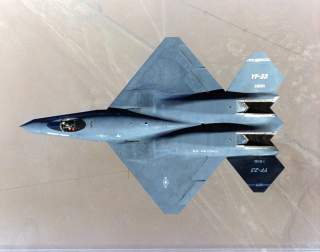This Is the Odd-Looking Fighter That Could Have Replaced the F-22 Raptor
So what happenned?
Both the Raptor and a fully operational F-23 would have carried eight air-to-air missiles internally—that was the Air Force requirement. Moreover, the operational jets were essentially identically in terms of avionics—both competitors had proposed similar avionics suites. In fact, the Raptor ended up with the radar that was originally proposed for the YF-23. Ultimately, the Air Force ended up with an excellent plane with the Raptor—but both the YF-22 and YF-23 were outstanding designs. Had Northrop won the competition, the F-23 might have been a better overall performer, but it would have likely been more expensive. With the F-23, the Air Force would have a greater margin of superiority over potential threats like the Chinese J-20 or the Russian PAK-FA. But would that have been worth the price differential? Hard to say—but one can only imagine.
In 1991, Lockheed won the Advanced Tactical Fighter (ATF) competition and went on to develop the stealthy world beating F-22 Raptor air superiority fighter.
While in many ways, Northrop’s losing YF-23 was a much better design, but the U.S. Air Force chose the Lockheed aircraft because it believed that company would better manage the development program—and because the service thought the Raptor would cost less.
Recommended: North Korea has Thousands of Tons of Chemical Weapons
At the time, Northrop was in the doghouse with the Pentagon and the U.S. Congress because of massive cost overruns on the B-2 Spirit stealth bomber and several other projects. Meanwhile, partner McDonnell Douglas wasn’t faring much better. “I don't know how the Air Force decided which contractors would build the ATF, but I can only assume that there was some long-overdue consideration of Northrop's dismal track record of test fraud, contract suspension and fines,” Rep. John Conyers (D-Mich.) told the LA Times years ago.
Recommended: Why the Korean War May Have Never Really Ended
But what would an operational F-23 have looked like? And what if General Electric’s revolutionary variable-cycle YF120 had carried the day?
Recommended: The Real Reason China Has Built a Massive Military
Even in 1991, in terms of raw performance, the General Electric-powered YF-23 was acknowledged to have been the best performer even compared to its Pratt & Whitney YF119-powered twin. The YF-23 had much better supersonic cruise performance, stealth and was only slightly less maneuverable at extremely low airspeeds.
“Interestingly the YF-22 and YF-23 had exactly the same trimmed AoA of 60°. The YF-23 could do it without thrust vectoring. Those V-tails were very powerful especially when coupled to an unstable airframe,” said one source who is intimately familiar with both the YF-23 and the Raptor. “The YF-22 probably had an advantage at very, very low airspeeds but neither company had enough time to investigate dynamic low speed, high AOA maneuvering. This was a good example of how a competition needs to consider the PR value of flight test events. Lockheed understood this and did high AOA and shot missiles and pulled 9Gs. All single point, benign condition events but they left an impression.”
The source added that in some ways, it might have cost Northrop the Advanced Tactical Fighter competition—barring the other factors involved in the selection.
“ACC [Air Combat Command] pilots were enamored with dogfighting and Lockheed gave a good visual demonstration of high AOA—albeit a very limited and benign test,” the source said. “Northrop chose not to do high AOA during DemVal and that was a mistake. Both airplanes could do the same exact maneuver—trimmed, high AOA. As it was, the YF-22 ‘appeared better’ because they did something visually exciting and Northrop couldn't—or so it was inferred.”
But what would all of that have meant for an operational aircraft? In either case, the U.S. Air Force would have received an outstanding air superiority fighter that has no equal. But while the Lockheed Martin F-22 is bar none the best air superiority fighter the United States has ever produced, an operational F-23 might have offered an even greater performance margin over potential adversaries than the Raptor currently does.
The final operational version of the F-23 would have offered much better range than the Raptor—especially at supersonic speeds—especially if powered by the YF120. That would have come in handy over the Pacific. It would also have been stealthier and it would have been almost as maneuverable as the Raptor—or possibly more so at different speeds and altitudes.
Both the Raptor and a fully operational F-23 would have carried eight air-to-air missiles internally—that was the Air Force requirement. Moreover, the operational jets were essentially identically in terms of avionics—both competitors had proposed similar avionics suites. In fact, the Raptor ended up with the radar that was originally proposed for the YF-23.
Ultimately, the Air Force ended up with an excellent plane with the Raptor—but both the YF-22 and YF-23 were outstanding designs. Had Northrop won the competition, the F-23 might have been a better overall performer, but it would have likely been more expensive. With the F-23, the Air Force would have a greater margin of superiority over potential threats like the Chinese J-20 or the Russian PAK-FA. But would that have been worth the price differential? Hard to say—but one can only imagine.
Dave Majumdar is the defense editor for The National Interest. You can follow him on Twitter: @davemajumdar.
This first appeared in 2015 and is being reposted due to reader interest.

